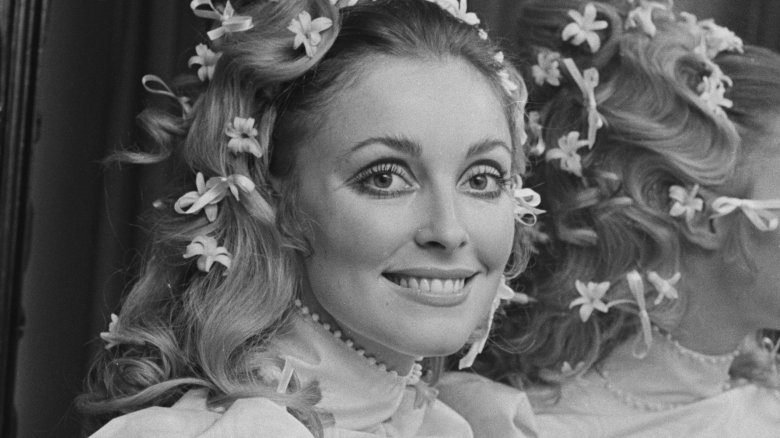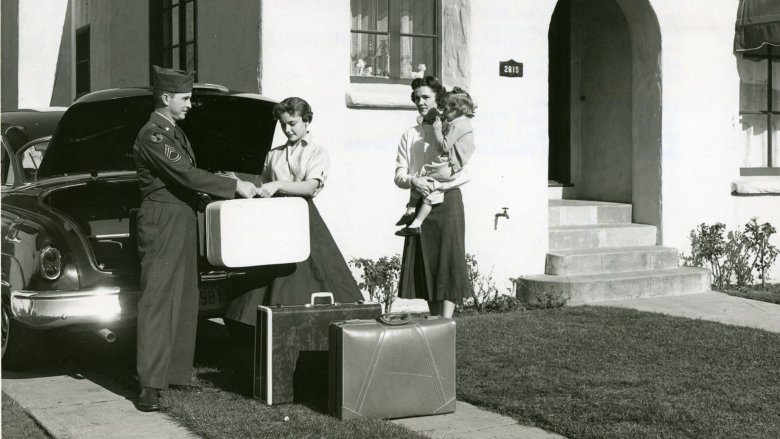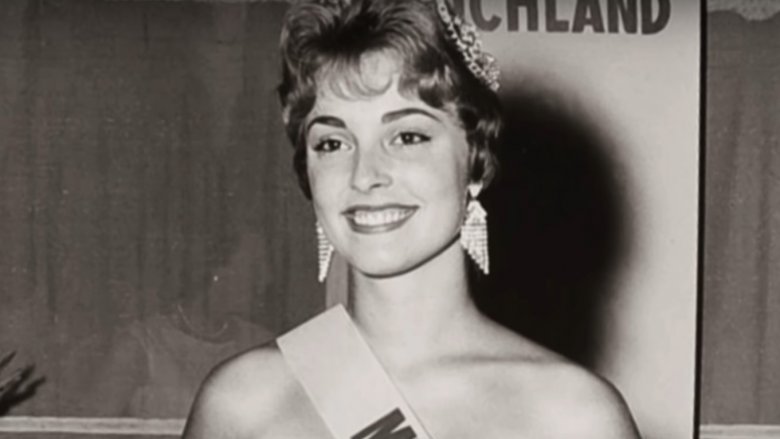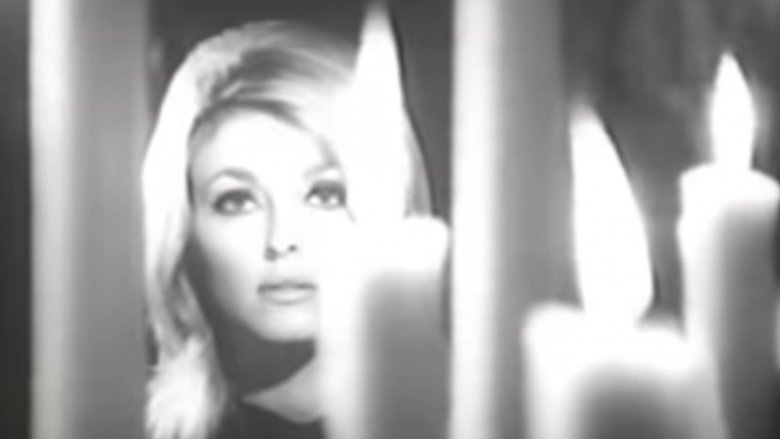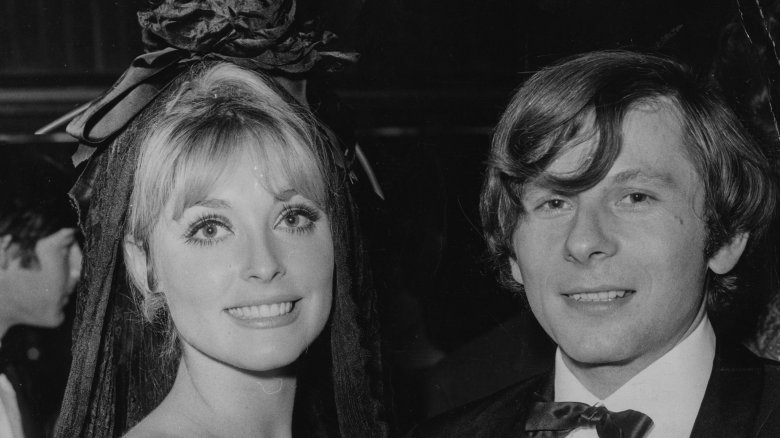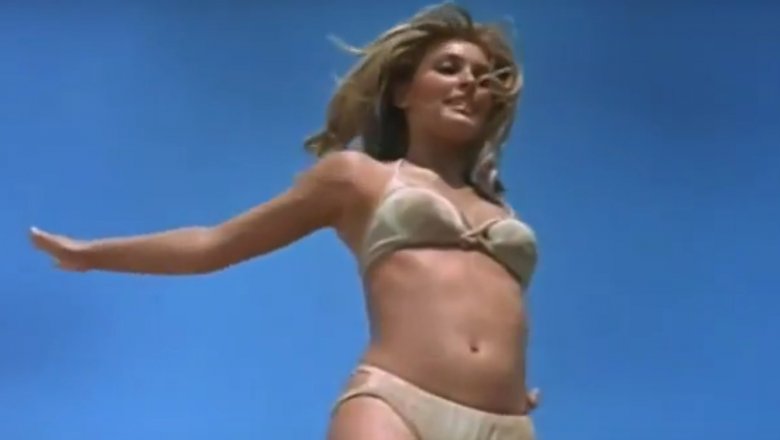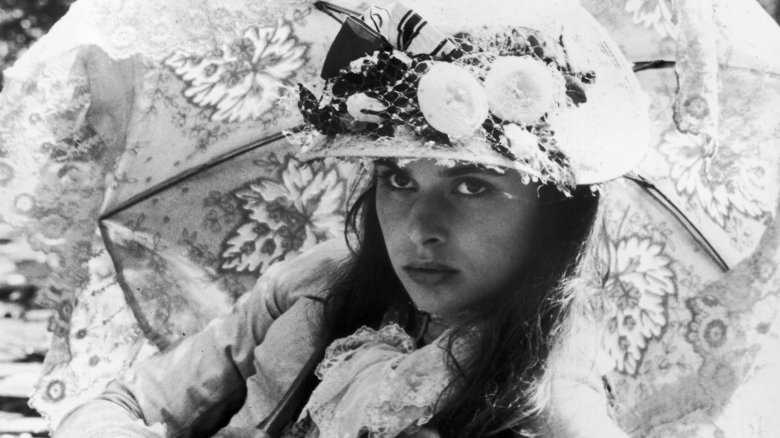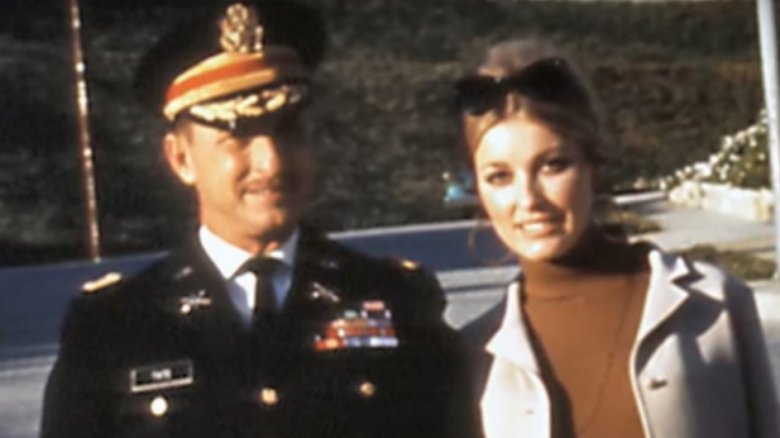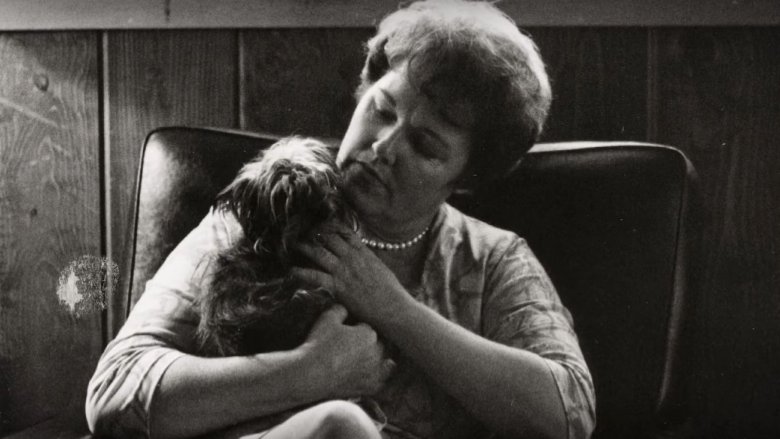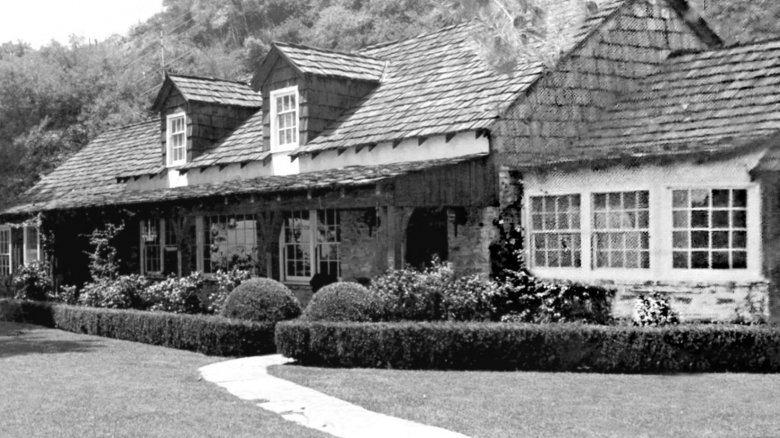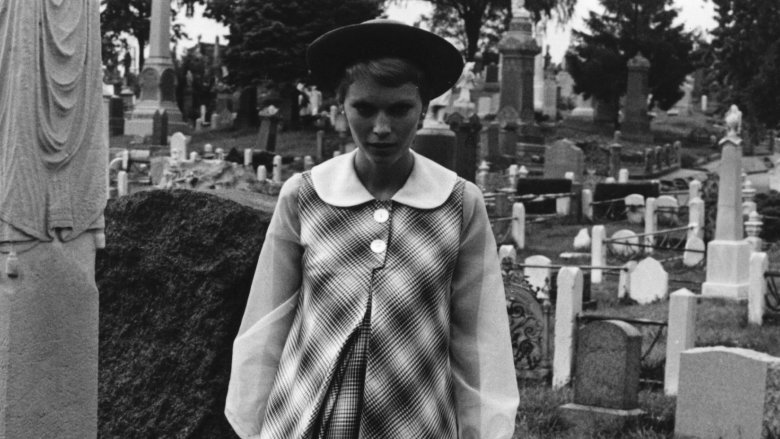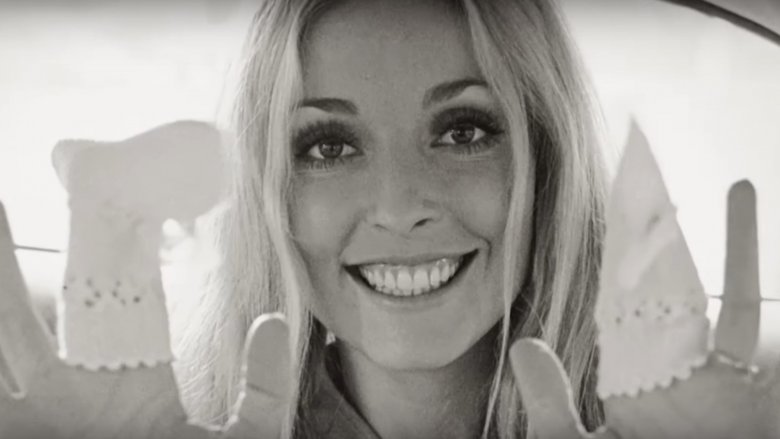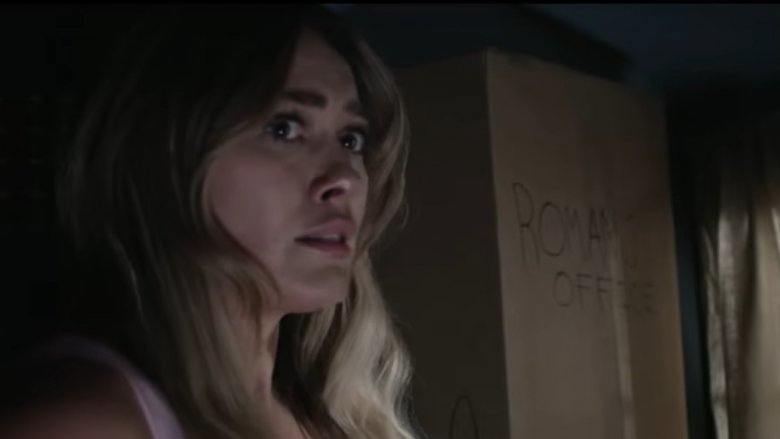The Untold Truth Of Sharon Tate
Sharon Tate, the brown-eyed ethereal star of '60s cult classics Valley of the Dolls and Eye of the Devil, is perhaps better known for how she died than how she lived. On August 9, 1969, three members of the infamous Manson Family entered Tate's sprawling French country-style home in the Benedict Canyon neighborhood of Los Angeles and brutally slaughtered everyone inside, including Tate's former lover and hairstylist to the stars, Jay Sebring; screenwriter Wojciech Frykowski; Frykowski's girlfriend, Angela Folger, heiress to the Folger coffee fortune; and Tate's unborn son. At the time of the murders, Tate, wife to director Roman Polanski, was almost nine months pregnant. She and the other victims had been stabbed multiple times. A fifth victim, 18-year-old Steven Parent, was shot to death in the driveway.
The grisly murders shocked and stunned L.A.'s glitterati, and Tate became a symbol of everything that was both enchanting and lethal about America's free love decade. But she wasn't simply a symbol, and she wasn't just a pretty face, either. She was a complicated human being with a layered personal history and talents that went far beyond her captivating smile and voluptuous body. The fact that she continues to fascinate filmgoers 50 years after her death — Quentin Tarantino has made her fate the centerpiece of his movie, Once Upon a Time in Hollywood — is testament to Sharon Tate's unique and lasting contributions to American popular culture.
An Army brat who stood out
Tate's father, Paul, was a colonel in the U.S. Army, so the family packed up every couple years, moving from Army base to Army base, town to town. As a young girl and teen, Tate lived in six different cities, and, according to Sharon Tate: Recollection, a book of vignettes about Tate's life compiled by her sister, Debra, Sharon blamed her shyness and inability to make friends on her family's itinerant lifestyle. People often confused Sharon Tate's shyness for aloofness, but nearly everyone who knew her swears she was as sweet-natured as she was beautiful.
Eventually, the family settled in Verona, Italy, where Sharon, having gotten a part as an extra on the film Hemingway's Adventures of a Young Man, was picked out of the crowd by actor Richard Beymer. For a short time, Tate dated Beymer, who'd made a name for himself the previous year playing Tony in the 1961 film version of West Side Story, and he encouraged Tate to pursue acting, introducing her to his agent and helping her find roles.
Later, when Tate's acting career was more established, she was thankful for having grown up in a strict, military household. Recollection claims she credited her father's insistence on proper behavior with preparing her for a life in show business: "I never resented his authority," she said. "In fact, I'm thankful for my strict upbringing; I feel it has helped me learn discipline — and that's very important in this business."
She was a beauty queen from the start
Tate was still in diapers when her beauty began to impress the public. At the tender age of six months, she took top honors in the "Miss Tiny Tot of Dallas" competition. According to the Too Young To Die episode about Sharon, her mother, Doris, was the driving force behind the beauty competitions, and in 1959, Sharon won five different pageants in one year, including Miss Tri-Cities, Miss Frontier Days, Miss Autorama, and Miss Water Follies. In her winning turn as a contestant in the Miss Richland pageant in Washington state, Tate told the judges she planned to go on to study psychiatry in college. She also hoped to compete for the Miss Washington title, but her father was ordered to Italy before she could.
Her beauty was recognized across the pond as well. Her Italian schoolmates named her homecoming queen and Italy's most beautiful American. Perhaps most noteworthy was her winning turn as Miss Stars and Stripes when she was in her late teens, which culminated in her straddling a missile in a bathing suit and cowboy hat. The picture graced the cover of Stars and Stripes magazine. Her austere, by-the-book father was not thrilled.
The Wicca-d Witch
Tate's first major role was that of a witch in the British occult horror film, Eye of the Devil. The movie tells the story of a young couple hoping to restore a vineyard to its former glory. Tate's character convinces the couple that grape vines will only respond to blood sacrifice. To make Eye of the Devil more, ahem, realistic, the filmmakers brought in a Wiccan high priest and his wife, Alex and Maxine Sanders, as consultants. In her autobiography, Fire Child, Maxine Sanders claims that Tate was fascinated by Wicca's neopagan rituals and became an adherent of sorts.
Whether or not Tate was really into Wicca, it cannot be denied that 1960s America was obsessed with the occult. Author R. Gary Patterson even notes that the Sanderses may have been in contact with aspiring Satanists living in the United States and that there might have been a link between Maxine Sanders and Tate's eventual murderers. Patterson writes that, prior to Tate's death, Maxine Sanders lent a book on blood sacrifice to one of her followers. When she got the book back, Sanders noticed that that someone had scribbled "kill the pig" in the margins. Sanders apparently didn't think much of the note until after Tate's murder: Tate's blood was used to write "pig" on the front door of her house.
Her big break came courtesy of a Frankenstein monster mask
Sharon Tate and Polish director Roman Polanski's relationship got off to a fittingly strange start. They first met over an uncomfortable dinner with producer Martin Ransohoff, after which Polanski invited Tate to his apartment. Having left her alone for several minutes, he reappeared wearing a Frankenstein's monster mask. Tate let out a "bloodcurdling" scream, and that scream convinced Polanski, who would later go on to direct Rosemary's Baby, that he should cast her as the lead in his new horror comedy, The Fearless Vampire Killers.
Meeting Polanski, falling in love with him, and eventually marrying him turned out to be a mixed blessing for Tate, who was nine years younger than her very powerful husband and was often intimidated and controlled by him. Tate, a product of a conventional family, wanted at least the semblance of a traditional marriage. Polanski, on the other hand, wanted the freedom to pursue other women, and rumors abounded about his infidelities and escapades.
In his biography of the starlet, Sharon Tate: A Life, Ed Sanders quoted Tate as having said, "We have a good arrangement. Roman lies to me and I pretend to believe him." Not exactly a fairy tale, but what do you expect when your relationship begins with a wail of terror?
A real-life Barbie
Sharon's sister Debra insists that Tate's character in the 1967 Tony Curtis-helmed beach romp "Don't Make Waves" inspired toy maker Mattel's Malibu Barbie. Mattel has never confirmed the rumor, but Tate's character, clad in a beige bikini for the majority of the film, was named "Malibu." Coincidence? Probably not.
Don't Make Waves manages in just a few short hours to touch on nearly every trope of mid-century California beach bum cinema. Bodybuilders, spiritual gurus, and bikinis are everywhere. There's even a mudslide that leads to each character ending up with the right girl/guy. In spite of all the attention the movie brought, not to mention the auditions and roles and endorsements it helped her land, Tate reportedly despised the film, which was based on Ira Wallach's 1959 novel, Muscle Beach.
The cheesy script could not blunt Tate's undeniable appeal. As Malibu, she begins the film saving a drowning Curtis with mouth-to-mouth resuscitation. Later, she takes a short but memorable turn on the trampoline. Perhaps that's where The Man Show got the idea. As is the case with Malibu Barbie's backstory, we may never know.
Sharon Tate and the Tess of the D'Urbervilles connection
Sharon Tate and Roman Polanski only made one film together — 1967's The Fearless Vampire Killers — but Tate had hoped they would make more. Prior to her death, she gave Polanski her copy of Thomas Hardy's novel Tess of the D'Urbervilles, telling him they should pair up and make a movie adaptation of the book.
It was an eerily prescient wish. Tess Durbeyfield's tragic arc shares a great deal in common with the tumultuous lives of Tate and Polanski. The novel tells the story of a young milkmaid who is raped and impregnated her evil employer, later abandoned by her well-meaning husband, and eventually imprisoned for killing her rapist. The resulting baby dies soon after it is born. Similarly, Tate, a beautiful innocent, married Polanski, by all accounts a serial philanderer, when she was just 25 and was killed a year later. Her unborn son likewise died in the attack. Furthering the eerie — and deeply troubling — coincidences, in 1977, Polanski pleaded guilty to raping a teenager. Having fled to France to avoid jail time, Polanski eventually put out Tess, his retelling of Hardy's story, casting Nastassja Kinski in the lead role and dedicating the film to Tate.
You just can't make this stuff up. Or you can, if your name is Thomas Hardy.
Her father went undercover to solve her murder
Sharon Tate's shockingly violent murder went unsolved for several weeks, and during that time her family lived in limbo, traumatized not only by the loss of their beautiful daughter and sister but by the sheer brutality of her killing and the police's seeming inability to solve the crime.
Tate's grief-stricken father, Paul, a former Army colonel, used his background in military intelligence to try to close the case himself, even going so far as to dress up in hippie outfits to hunt down the perpetrators. Paul was, according to his daughters, a firm and unyielding parent. California hippie was not a role that came naturally to him. Still, he was willing to do whatever it took to bring his daughter's killers to justice.
Law enforcement eventually pinned the killings on Manson Family members Tex Watson, Susan Atkins, and Patricia Krenwinkel, and so while it's true that Paul Tate's detective work failed to produce any solid leads, it was clearly a labor of love. Incidentally, Sharon's son was posthumously named Paul Richard Polanski, in honor of her and Polanski's fathers.
Her mother was a pioneer in the victims' rights movement
Sharon's murder at the hands of the Manson clan obviously had a profound impact on her family. Her mother was perhaps the most changed by the tragedy. An Army wife, pageant mom, and beauty salon owner, Doris Tate went on to become a leading voice in the victims' rights movement, founding COVER, the Coalition on Victim's Equal Rights, and advocating for the use of victim impact statements in sentencing hearings.
For several years after Sharon's death, Doris Tate was a recluse, struggling with grief and depression. Then Doris got word that Leslie Van Houten, a Manson Family member convicted in the murders of Leno and Rosemary LaBianca, was hard at work trying to amass the signatures needed to be granted parole, and Doris launched her own campaign to make sure Van Houten remained in prison. In 1992, President George H.W. Bush honored Doris Tate and her work as a victim's rights advocate as part of his "Thousand Points of Light" initiative. Doris Tate died that same year of a brain tumor.
A deadly address
The French country-style house at 10050 Cielo Drive where Tate and her friends were murdered has a fascinating history all its own. Designed for the actress Michele Morgan, it saw a number of famous inhabitants, including Lillian Gish, Henry Fonda, and Carey Grant. Prior to Tate's residency, it was occupied by actress Candice Bergen and Terry Melcher, the son of Doris Day. Then Bergen and Melcher broke up, Doris talked Melcher into living with her for a while — partially because she was worried about Charles Manson, who kept hanging about the Cielo Drive house — and Tate and Polanski moved in.
Charles Manson, at one time an aspiring musician, targeted the occupants of the home because he'd been spurned by Melcher, whom he'd hoped would produce his debut album. Furious at Melcher for turning him away, Manson convinced three of his followers — Tex Watson, Susan Atkins, and Patricia Krenwinkel — to kill everyone in the house. The murders were astoundingly brutal. The pièce de résistance? The word "pig" scrawled on the front door in Sharon Tate's blood.
In 1994, the home was bulldozed, but not before Trent Reznor of Nine Inch Nails could record his triple platinum album The Downward Spiral there. Perhaps it will come as no surprise to fans that Reznor made sure to grab that door, the one that had "pig" written on it, on his way out.
The curse of Rosemary's Baby
Roman Polanski's film of Ira Levin's much-lauded book came out in 1968 to a chorus of critical acclaim. So far so good for a movie about a woman unwittingly giving birth to the devil's child in order to jump-start her husband's floundering acting career. Then the creepy coincidences began. First, the film's composer, Krzysztof Komeda, fell off a cliff and went into a coma, dying shortly thereafter. Next and not nearly as dramatic, the film's producer, William Castle, suffered a horrible attack of kidney stones, during which he is reported to have hallucinated and hollered for Rosemary to drop the knife. (His career took a nose dive after that.) Finally, Polanski really wanted Tate for the role of Rosemary, but Mia Farrow got the part instead and Tate was murdered just a year after the movie was released. Stabbed to death, no less, and heavily pregnant.
According to Too Young To Die, Polanski told a number of friends that, just before Tate left him for Los Angeles, he had a premonition that he would never see her again. Perhaps it was paranoia brought on by making one of the more disturbing films of the late '60s (which is really saying something). Or maybe he was cursed with second sight.
Sharon Tate reincarnated?
In the 1990s, a woman named Rosie Blanchard began harassing Sharon Tate's mother, Doris, and sister Patti, claiming to be the reincarnation of Sharon. When Patti asked Blanchard to stop spreading such a harmful fiction, Blanchard changed her story and began insisting that, in fact, she was Sharon Tate's daughter.
Blanchard found an unexpected ally in William Garretson, who had been the teenage caretaker of Tate's house at the time of her death and the first suspect taken into custody for the killings. Initially, Garretson swore he slept through the murders, and police did end up letting him go when forensic evidence cleared him of having any role in the crime. Years later, Garretson changed his story, saying what really happened was Tate actually gave birth to a child shortly before she was killed, only to have that child whisked away by a bunch of men in black suits. That child, Garretson said, grew up to be Rosie Blanchard. Garretson and Blanchard married shortly after Blanchard initiated contact with the Tate family. Yeah, that's a weird one.
She's still haunting us, 50 years after her death
Sharon Tate was well on her way toward achieving muse status when she was killed, and long after her death, she continues to inspire writers, directors, and designers alike.
Mad Men fans will remember Megan Draper's T-shirt from "The Better Half" episode, an obvious nod to Sharon Tate's titillating 1967 Esquire spread in which she wore a sopping wet shirt with a red star on it. In a show lauded for its beautiful and period-accurate costumes, Megan's shirt caused quite a stir, leading many loyal watchers to speculate that Don's aspiring actress wife was either doomed or dead already, a lovely figment of her husband's disturbed imagination.
From the small screen to the silver, Quentin Tarantino's Once Upon a Time in Hollywood explores Tate's LA life from the perspective of her neighbor, played by Leonardo DiCaprio. DiCaprio is Rick Dalton, an aging movie star, to Margot Robbie's Tate. Tarantino has described the movie as a love letter to 1960s Hollywood. Last and definitely least, there's the Hilary Duff horror vehicle, The Haunting of Sharon Tate, another take on Tate's murder that is by all reports terrible, like Eye of the Devil, in which Tate played a witch bent on blood sacrifice.
